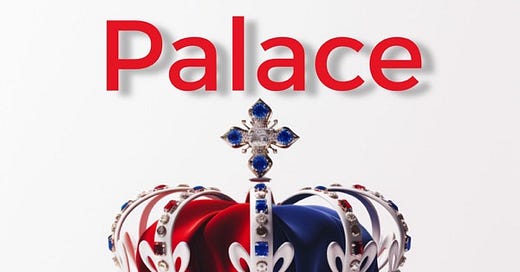The Majesty of Trooping the Colour
Nobody—and I mean nobody—does pageantry quite like we British.
One cannot witness the splendour of Trooping the Colour without being reminded of precisely why the monarchy has endured for over a millennium. Whether you're a devoted royalist, a constitutional monarchist, or indeed a podcaster residing in the gilded exile of Montecito, one immutable truth remains: nobody—and I mean nobody—does pageantry quite like we British.
The precision of the Household Division, the thunderous echo of hooves on Horse Guards Parade, the crimson and gold that catches the June sunlight—it is theatre in its most sublime form. But it is also far more than mere spectacle. It is a reminder of duty, of service that transcends the individual, and of an institution that has weathered wars, scandals, and the shifting tides of public opinion.
More poignantly, it serves as a reminder of continuity itself. There, on that balcony at Buckingham Palace, one observes the living embodiment of our constitutional future: Charles, no longer the heir apparent but the sovereign in his own right; William, steady and prepared for his eventual burden; and young George, blissfully under-aware that he represents the third generation of our monarchical tomorrow.
But perhaps most remarkably, one witnesses the transformation of Catherine—the former Miss Middleton, that perfectly ordinary girl from Berkshire who has become anything but ordinary. There she stands, radiant in her confidence, every inch the Princess of Wales, and one cannot help but marvel at the journey. From the commoner who caught a prince's eye at university to the woman who now embodies the very essence of what a modern royal should be.
I have observed many within these palace walls over the decades, and I can say with authority that Catherine possesses something increasingly rare in royal circles: an authentic connection to the people she serves. She has mastered the delicate art of being relatable without being common, approachable without sacrificing dignity. When she engages with families at a children's hospice or champions mental health initiatives, there is no performative quality to her compassion—it is genuine, and the public senses this authenticity.
The irony is not lost on those of us who remember the Diana years. Here we have Catherine, the commoner, who may well become the People's Queen that some believed Diana might have been, had circumstances been different. But where Diana's relationship with the institution was often turbulent, Catherine has embraced it wholly. She understands, in a way that perhaps only an outsider can, the profound responsibility that comes with the privilege.
Her Majesty Queen Elizabeth II, God rest her soul, recognised this quality early on. I recall palace conversations where Her Late Majesty spoke approvingly of Catherine's dedication to duty, her unwavering support of William, and most importantly, her grasp of what the monarchy represents to the Commonwealth realms. Elizabeth saw in Catherine not just a suitable wife for her grandson, but a steadying influence for the institution itself.
The sight stirs something profound, even in those of us who have grown rather too familiar with palace corridors and the machinations therein. Here is permanence in an age of ephemeral celebrity, tradition in an era that often mistakes disruption for progress. And in Catherine, we see the evolution of that tradition—maintaining its dignity whilst making it accessible to a new generation.
And yet, one cannot help but feel the absence—the tragedy, if you will—of Prince Harry being some eight time zones away. Whatever one's feelings about recent... unpleasantness, there remains something fundamentally melancholy about a son of the realm watching such moments, if at all, through a screen rather than standing with his family. The empty space beside William speaks volumes about choices made and bridges burned, about the difference between those who understand service to the Crown and those who mistake the Crown as being in service to them.
The contrast becomes even more stark when one considers what Harry has abandoned. Here was a prince who once commanded genuine affection from the British people, who served with distinction in Afghanistan, who possessed that rare royal gift of connecting with ordinary citizens. And yet he chose to step away from all of this—from the continuity, from the duty, from the profound privilege of serving something greater than oneself.
I am reminded of conversations with palace staff who speak of Harry's early years with genuine fondness. They remember a young man who understood instinctively what his grandmother represented, who seemed to grasp the weight of his position. But somewhere along the way—and I suspect the influences of Montecito played no small part—that understanding was replaced by grievance, that sense of duty by a sense of entitlement.
Though I confess, one wonders: were he there upon that balcony, would he not inevitably feel the weight of being the spare standing beside the lineage? The cruel arithmetic of monarchy is unforgiving in its hierarchy. William and Catherine, George, Charlotte, and Louis—they represent the direct line, the future. Harry, even at his most dutiful, would always have been in their shadows. Perhaps, in his California sanctuary, he has found peace with a role that biology denied him—though at what cost to the institution that shaped him, and to the family that mourns his absence even as they carry on without him.
The tragedy extends beyond Harry himself. His children, Archie and Lilibet, grow up disconnected from their heritage, from the weight of history that should be their birthright. They will know California sunshine but not the solemnity of Westminster Abbey, Hollywood parties but not the quiet dignity of Balmoral. They are being raised as Americans with royal titles they may never truly understand.
The drums fade, the crowds disperse, but the Crown endures. Long may it reign.
Deep Crown writes weekly for Palace Intrigue. His insights come from decades observing the House of Windsor from both inside and outside the palace walls.


